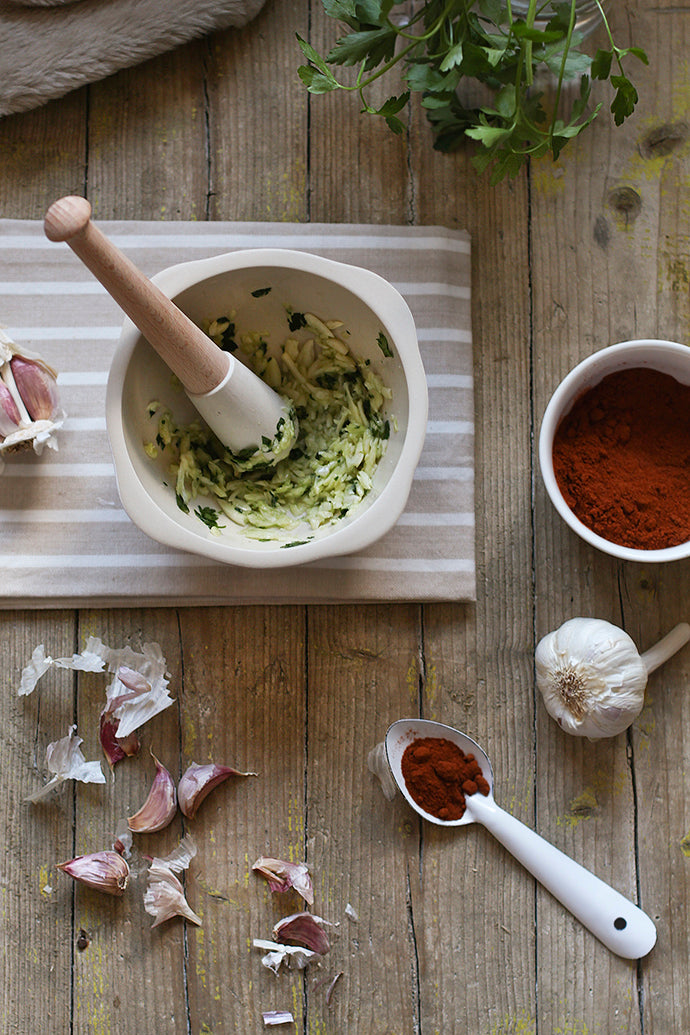I bring news that you will surely like! Today we welcome Beatriz, author of the food blog To Be Gourmet, as a contributor to the blog. To reach everyone in the warmest, most everyday way, she has prepared a recipe with everyday ingredients and no extravagance: she brings us a dish that is not difficult to prepare, but has a special touch, tasty and healthy. Welcome Beatriz! Enjoy the recipe!

This is a very convenient dish, it is prepared quickly and can also be served as a main course since legumes together with cereals, in this case rice, make a perfect combination, as they manage to form a protein of high biological value.
This is a traditional home recipe that I always love to eat again. The intense flavor of the garlic mash combined with the paprika makes this a delicious stew that is always well received by everyone on cold days when you crave spoon food.
On this occasion I presented it in a dish that I think is ideal for plating and serving directly at the table. It's the Emile Henry ceramic mold.

Although it is a mold intended for making delicious quiches, I find it beautiful as a vessel to use with other types of preparations. Being ceramic it retains heat and prevents the food from cooling down, so we can show off our dishes or stews on the tablecloth and everyone can serve themselves the amount they want.
Ingredients
- 350 g of chickpeas
- One head of garlic
- 120 g of rice
- One cube of concentrated chicken stock
- A few sprigs of parsley
- A couple of bay leaves
- Extra virgin olive oil
- Salt
Preparation
The night before we leave the chickpeas to soak in a bowl with water. The next day we drain them and place them in the pressure cooker; I use the one I have had forever the WMF one.
We add a little water, a couple of fingers above the chickpeas, and put over medium heat without covering completely.
Meanwhile in a mortar we mash the garlic and parsley with a little salt. The Emilie Henry I like a lot because it has large capacity, it's more hygienic than wooden ones, and it holds the contents very well.
With a skimmer if you have one, otherwise with a spoon, we skim the water in which the chickpeas are cooking to remove impurities and pour in the mash. We add the concentrated stock cube and close the cooker. When the rings have risen we count 7 or 8 minutes. We turn off the heat and wait for the rings to drop completely before opening.
We open the cooker, add the rice and keep over medium heat. In a small pan we put a drizzle of extra virgin olive oil and add two or three tablespoons of paprika. We let it heat, being careful not to burn it, one or two minutes is more than enough, and add it to the stew.
We wait about fifteen minutes for the rice to cook with the pot uncovered. At the last moment we adjust the salt.
We transfer the chickpeas to the quiche mold to present them at the table. Previously we can leave it a few minutes in the oven at 50º so that it is warm and keeps the stew's warmth even better.

A succulent and very complete dish that will surely be enjoyed.
Beatriz



























Comments
Claudia&Julia said:
Hola Manue,
Puedes añadir el laurel al poner el agua para cocer los garbanzos y retirarlo antes de presentar el plato en la mesa.
¡Un saludo!
Manue said:
Y el laurel???
Carmen said:
Tiene una pinta estupenda,probaré esta receta.Aunque para clasificarla como veggie no puede llevar caldo de ave,con uno vegetal quedaría también de lujo.
delia bertran said:
practico todas las recetas .algunas las guardo para el tiempo de los frios esquisitas y economicas gracias¡¡¡¡¡busco receta de pato confitado en oliva regracias de nuevoDelia
maria said:
Uno de mis platos favoritos para el invierno.
Las fotos que lo presentan, son de nota, estupendas.
Saludos.